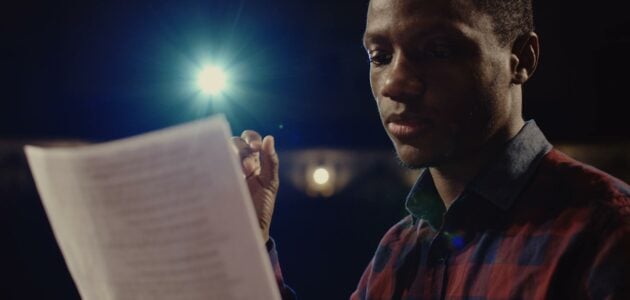
Get To The End of The Line
“Get to the end of the line!” – We’ve all heard this note before, and for good reason. The ability to drive a line through to the end separates amateur actors from the pros. Good performances have drive. The intention of the thought behind the line is clear and specific. Performances that lack these qualities will see actors dropping off at the ends of their lines.
This is bad news for audiences. When actors keep dropping off, the audience inevitably misses what the actor is saying. Worse still, they are unclear on why the actor is saying it and lose interest in the story.
Why Do Actors Drop Off?
Dropping off before the end of the line is usually a sign of uncertainty on the part of the actor. Sure, sometimes we will need to play uncertain characters. However, as performers, our skill is in delivering powerful performances no matter how understated our character’s traits may be. There’s always technique at play even if the character is one who mumbles or struggles with shyness.
Even anxious characters will try to get their point across by focusing their thoughts and intentions on the other character. Even if they are unsure about their thoughts, the thoughts are sent to the other character. Furthermore, those thoughts are sent with the intention of being received. The tendency to drop off before the end of a line is a manifestation of uncertainty on the part of the performer, not the character.
Wading off the ends of sentences or thoughts is weak, lifeless and uninteresting. When actors start losing the ends of their lines, the audience starts flipping through the playbill (and wishing they were on their couch binging Netflix and UberEats). To keep our audiences engaged, we must also stay engaged with the fullness of the language and the ideas that underpin it.
The audience will follow you as long as you don’t lose sight of your actions and objectives.
As actors, our confidence in our character’s intentions will help us drive those thoughts to affect the other actor. This, in turn, will capture our audience’s attention.
How to Get To The End Of the Line
So, how can we ensure our fellow actors and audiences are being affected by our performance? It’s simple… but not always easy.
Take in what has been said to you, let it affect you and then respond. This is all basic acting stuff, but the key is to do it all quickly. Turning up the pace can instantly transform a slug-fest into a fiery piece of theatre. This usually happens towards the end of the rehearsal process, when the intentions and thoughts are clear. You may hear your director politely shout at you – ‘pacey pacey darlings!’, this is your cue that it’s time to heat it up.
The audience will follow you as long as you don’t lose sight of your actions and objectives. Throughout your rehearsal period, play both of these with full commitment.
If you need a refresher on how actors use ‘actions’, we highly recommend Actions: The Actor’s Thesaurus.
Allow your speech to be influenced by the intensity of your intention. When actors can hit the keywords in the character’s speech, we make it clear and easy for our fellow performers and audiences. This clarity allows our audience to grasp the meaning and experience the story.
Practical Exercises
How do we take this note on? If you find yourself getting this note, try this exercise:
- Get a tennis ball or other bouncing ball and find a wall you can safely bounce it against.
- Imagine that your ‘thought’ or intention is contained within the ball.
- Prepare to throw the ball. As you say the line of text, release the ball with some force against the wall.
- Catch the ball as it comes back to you, and move on to the next line.
- Do this for each line of the text.
- Notice how the physical action of sending the thought influences the way you say the words.
- Practice this a few times to imbue the text with new energy and intention.
- Fun bonus: If you are rehearsing a scene with a partner, why not get them to join you? Throw the ball to them directly while saying your lines, and get them to do the same back. You will absolutely notice a change in the way you deliver the text. Pay attention to the new power of the lines and the drive in the performance. Feel free to discuss these changes with your scene partner afterwards.
Lastly, a quick note on pauses: Pauses should come naturally. They also must be earned. If you pause too much in a speech you will lose your audience, and they will ‘get ahead of you’. This spells disaster for the performance. As soon as the audience checks out, they lose interest in the next moments of the performance. Remember that a pause can hold more value than text, so don’t overindulge in them and rob them of their power.
Closing Thoughts
The next time a director tells you to “Get to the end of the line,” remember that this note is for everyone’s benefit. Actors who can get to the end of the line bring their performances to life at a professional level. As we’ve touched on, this note is really about what lies underneath the character’s text.
As an actor, the clarity of thought and intention that you bring to the text will reveal your character’s motivation and story. Hitting your keywords and moving through the text with pace will give your performance energy, vitality and motivation. Don’t allow the uncertainty you may feel as a performer to limit the fullness of your character’s expression.
Commit to getting to the end of the line, and you will find your performance lifts in every way.
Want to practice getting to the end of the line in a rewarding and fun environment? Join our StageMilk Drama Club to get professional, individual feedback every month to help you take your acting to the next level.


Leave a Reply